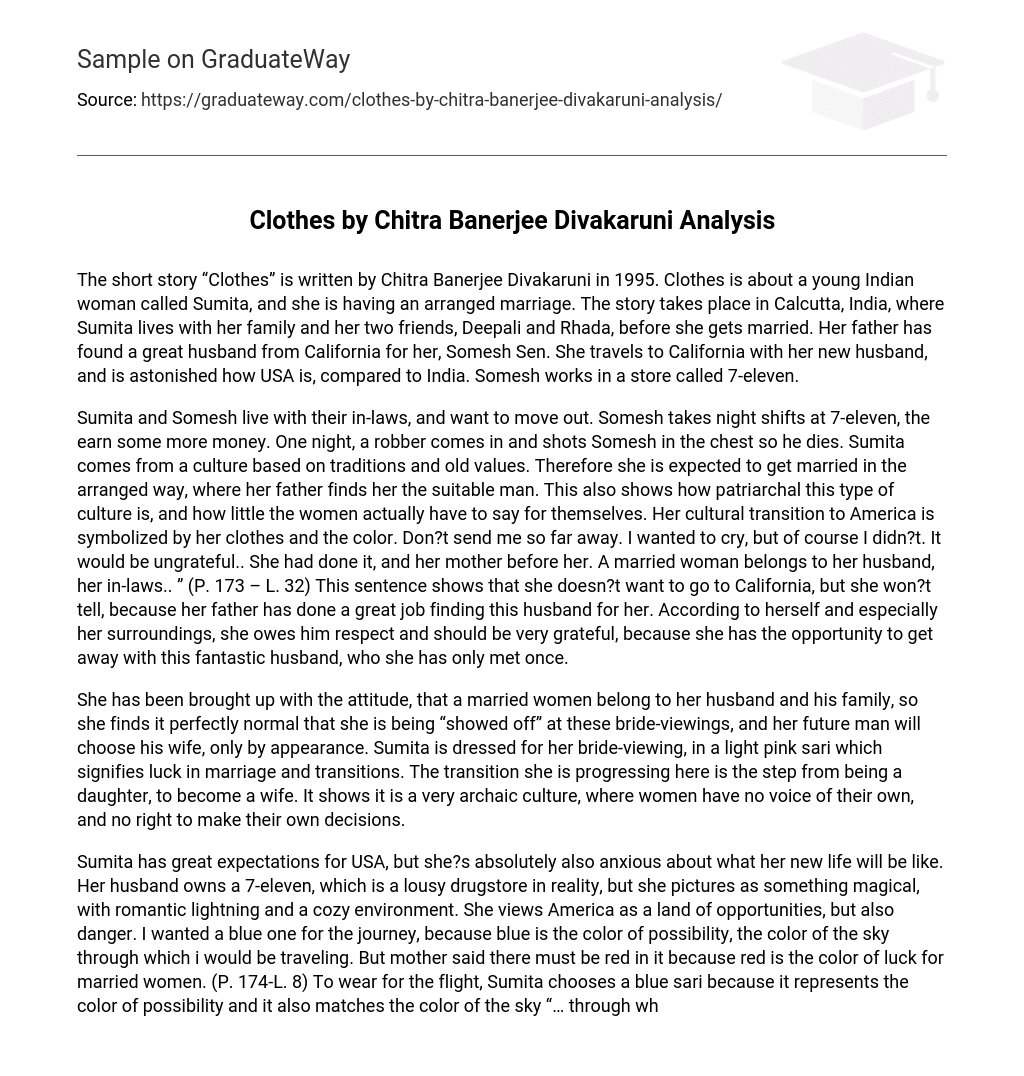The short story “Clothes” is written by Chitra Banerjee Divakaruni in 1995. Clothes is about a young Indian woman called Sumita, and she is having an arranged marriage. The story takes place in Calcutta, India, where Sumita lives with her family and her two friends, Deepali and Rhada, before she gets married. Her father has found a great husband from California for her, Somesh Sen. She travels to California with her new husband, and is astonished how USA is, compared to India. Somesh works in a store called 7-eleven.
Sumita and Somesh live with their in-laws, and want to move out. Somesh takes night shifts at 7-eleven, the earn some more money. One night, a robber comes in and shots Somesh in the chest so he dies. Sumita comes from a culture based on traditions and old values. Therefore she is expected to get married in the arranged way, where her father finds her the suitable man. This also shows how patriarchal this type of culture is, and how little the women actually have to say for themselves. Her cultural transition to America is symbolized by her clothes and the color. Don?t send me so far away. I wanted to cry, but of course I didn?t. It would be ungrateful.. She had done it, and her mother before her. A married woman belongs to her husband, her in-laws.. ” (P. 173 – L. 32) This sentence shows that she doesn?t want to go to California, but she won?t tell, because her father has done a great job finding this husband for her. According to herself and especially her surroundings, she owes him respect and should be very grateful, because she has the opportunity to get away with this fantastic husband, who she has only met once.
She has been brought up with the attitude, that a married women belong to her husband and his family, so she finds it perfectly normal that she is being “showed off” at these bride-viewings, and her future man will choose his wife, only by appearance. Sumita is dressed for her bride-viewing, in a light pink sari which signifies luck in marriage and transitions. The transition she is progressing here is the step from being a daughter, to become a wife. It shows it is a very archaic culture, where women have no voice of their own, and no right to make their own decisions.
Sumita has great expectations for USA, but she?s absolutely also anxious about what her new life will be like. Her husband owns a 7-eleven, which is a lousy drugstore in reality, but she pictures as something magical, with romantic lightning and a cozy environment. She views America as a land of opportunities, but also danger. I wanted a blue one for the journey, because blue is the color of possibility, the color of the sky through which i would be traveling. But mother said there must be red in it because red is the color of luck for married women. (P. 174-L. 8) To wear for the flight, Sumita chooses a blue sari because it represents the color of possibility and it also matches the color of the sky “… through which I would be travelling”. But her parents decide, and she wears a midnight-blue with a thin red border. Once Sumita is in America, the transition from wife to woman begins. Her husband, Somesh, buys her American clothes, and she proudly tries them on and shows them of in the mirror for him. The American clothes is a sunrise orange t-shirt and it says “Great America” on it, and a matching pair of jeans.
At this point, Sumita realizes that she is a young and beautiful Indian woman. She has beautiful breasts, hips and curves on her body. Sumita is more independent, then when she left from India. But the in-laws still decide what she has to wear One night, there is a robbery in the store Somesh works in. The robber takes the money, and shoots Somesh. Now Sumita is wearing a plain white sari with thick voile. “White. Widows color, color of endings. ” (P. 180-L. 16) Sumita is now a widow. She is now almost a fully-grown woman.
Her in-laws suggest, that she returns back to India with them. If she returns, she is back to square one. If she stays, she can become an American woman, and fulfill her dream becoming a girl school teacher. The story ends with the phrase “She wears a blouse and skirt the color of almonds. ”(P. 183-L8). Almonds, brown, natural. She decides to stay in America, and become an independent woman. Sumita has now gone through the transition of being a young and dependent Indian girl, to a grown and independent American woman.





